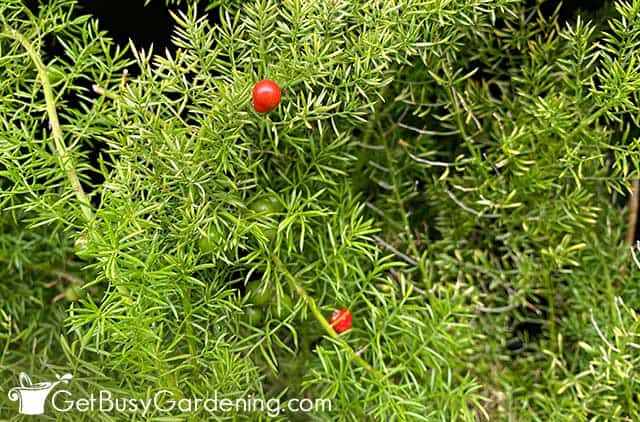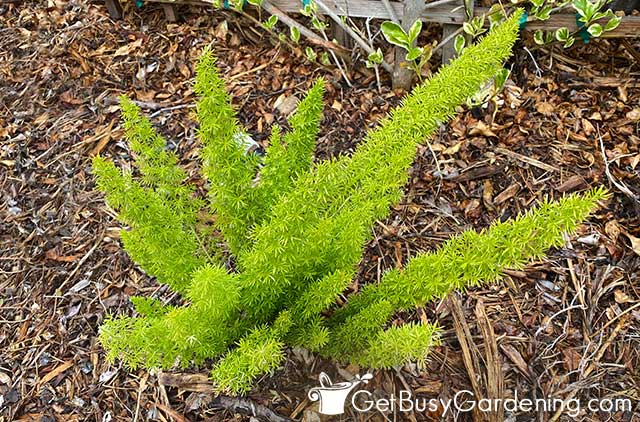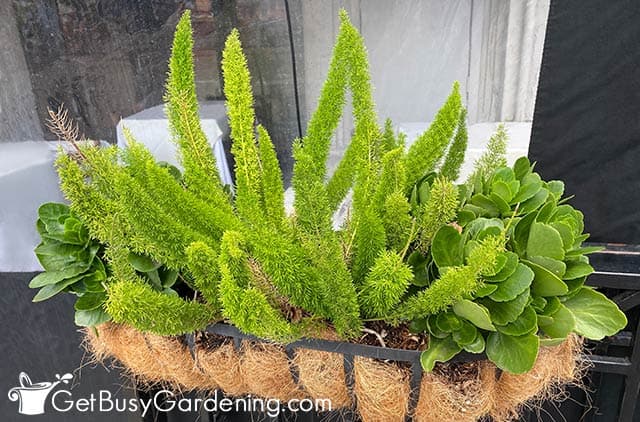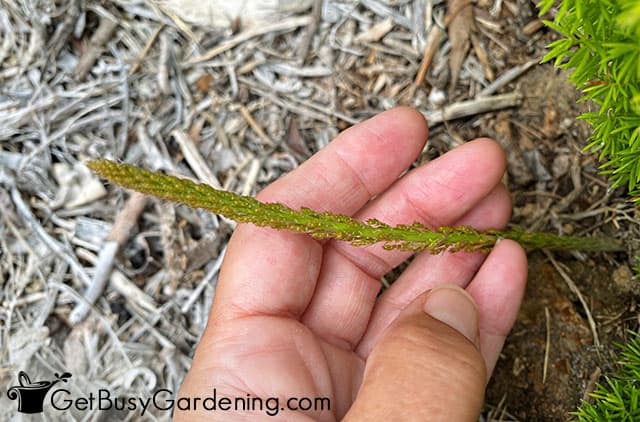Foxtail fern is a lovely plant that doesn’t require any special care. In this post I’ll tell you all you need to know about growing it, so you’ll have the best success.

The tough and low-maintenance nature of the foxtail fern makes it a great choice for beginners to grow.
But even easy plants like this one have needs. Learning to meet them is the best way to keep yours thriving.
This guide is designed to teach you exactly how to care for a foxtail fern, and what their growing needs are.
From the right light, water, and soil to use, to how to prune and propagate it, everything is included here.
Foxtail Fern Quick Care Overview
| Scientific name: | Asparagus densiflorus ‘Myersii’ (aka ‘Myers’) |
| Classification: | Tropical plant |
| Common names: | Foxtail Fern, Asparagus Fern Myers, Emerald Fern, Hounds Tail |
| Hardiness: | Zones 9-11 |
| Temperature: | 65-75°F |
| Flowers: | White, blooms spring-early summer |
| Light: | Full to part shade, indirect to low light indoors |
| Water: | Allow soil to dry between waterings, do not overwater |
| Humidity: | Average to high |
| Fertilizer: | General purpose plant food spring through fall |
| Soil: | Fertile and well-draining |
| Common pests: | Spider mites, mealybugs, scale |
Information About Foxtail Fern
The foxtail fern (Asparagus densiflorus ‘Myersii’ or ‘Myers’) is a cultivar of an herbaceous perennial plant that’s native to South Africa.
The upright, fluffy green fronds can grow up to 3’ tall and resemble a fox’s tail, earning it nicknames like foxtail fern and hound’s tail.
Despite the name and similar growth patterns, they’re not actually true ferns, because they reproduce via seed, rather than spores.
It’s a salt and drought tolerant plant that can be grown outdoors in the ground or containers, or indoors as a houseplant.

Flowers
With the proper care, foxtail ferns can produce tiny white flowers on long plumes during spring or early summer.
When they fade, bright red berries will form, which can be left to dry and then collected for seeds.
The blossoms are fragrant and pretty, but unfortunately they are very uncommon on indoor plants.

Toxicity
Unfortunately the flowers and berries are toxic to both people and pets when ingested. They can also cause mild skin irritation.
It’s best to keep this out of reach of your children, cats, and dogs to be safe. You can find more information on the ASPCA website.

How To Grow Asparagus densiflorus ‘Myers’
Before we talk about foxtail fern care, we should first discuss where to grow them. Choosing the right location is essential to their sustained health.
Hardiness
Asparagus densiflorus ‘Myers’ has tuberous roots that can survive temperatures down to 20°F and regrow the following spring.
It’s hardy in zones 9-11, but the foliage is only evergreen in areas that don’t experience consistent temperatures under 50°F.
Where To Grow Foxtail Fern
In warm enough climates a foxtail fern can thrive outdoors year around. They’re popular as perennial borders and ground covers.
In regions with freezing temperatures, they’re better kept in containers that can be overwintered in a sheltered location or grown exclusively as houseplants.
Though some of its relatives can be invasive, Asparagus densiflorus ‘Myersii’ doesn’t tend to spread as much or as quickly.
However, if this is a concern for you, then keep it in a container rather than planting it in the ground.

Foxtail Fern Care & Growing Instructions
Now that you know where to grow a Myers asparagus fern, it’s time to talk about the ideal care. Use the following tips to help yours thrive for many years.
Light
Direct sun can be too harsh for foxtail ferns. The foliage will burn when exposed to afternoon rays, especially in hot climates.
Instead, opt for a partial shade location that gets direct exposure only in the morning or evening.
Indoors, choose a spot with bright, indirect or diffused light, such as a west or east facing window. You may need to use a grow light if yours is in a dark room.
Water
The tuberous root system of Asparagus densiflorus ‘Myersii’ allows it to store water for a long time, making it drought tolerant.
But if it’s allowed to completely dry out for long periods of time, the foliage will begin to wilt and suffer.
Provide deep drinks whenever the top 3” feels dry. A moisture meter can really help you understand when it’s time, if you struggle with it.
Water thoroughly until it begins to come out of the drainage holes in the bottom of the pot. Always discard all excess, and avoid leaving it in soaking to prevent issues like rot.
Humidity
Foxtail ferns prefer a moderate to high humidity environment, around 40% or more. You can use a monitor to check it.
Outdoors this usually isn’t a problem, but indoors they may need more. You can try misting, placing it on a pebble tray filled with water, or running a humidifier nearby.

Temperature
The ideal temperature range for successful foxtail fern care is between 65-75°F.
The tubers can survive lows all the way down to 20°F, but the foliage will begin to die back at anything under 50°F.
High heat can cause browning, so provide plenty of shade and water when it starts to exceed 80°F.
Fertilizer
Feeding your foxtail fern during the spring and summer is a good way to keep it thriving.
Use slow release granules once per season, or a diluted liquid fertilizer monthly.
Choose a balanced, organic liquid option like compost tea, liquid kelp, or fish emulsion.
Soil
Asparagus densiflorus ‘Myersii’ can thrive in many types of potting soil. But they’ll grow best in a rich, slightly acidic, well-draining mixture.
Outdoors you can amend clay or sandy soils with compost. Indoors, you can make your own by mixing 3 parts potting soil with 1 part each of perlite and peat moss.
Repotting
Foxtail ferns are fast growing, and may require repotting as part of their annual care routine.
Look for roots emerging from the drainage holes or over the surface of the soil. Move them up no more than one pot size in the spring.

Pruning
There’s no real need to trim a foxtail fern, but it is a good way to keep it looking and growing its best. They’re very tolerant of hard pruning.
In the spring you can pinch off new tips to encourage branching. The rest of the year you can use sharp, sterile precision pruners to clip off discolored or dying stems as needed.
Pest Control Tips
Healthy foxtail ferns rarely have issues with pests, but occasionally spider mites, mealybugs, and scale can become an issue.
Treat any bugs you see immediately with natural pest control. Neem oil or an insecticidal soap are both good options.
I make my own spray by combining 1 teaspoon of gentle liquid soap with 1 liter of water.
Foxtail Fern Propagation Tips
Foxtail ferns can be propagated by seed or division. Since seeds can be difficult to obtain and germinate, especially from indoor plants, dividing the rootball is more common.
Simply remove the plant from its container and brush away the dirt. Use a sharp sterile knife to cut the rootball into sections that have both fronds and roots.
Replant them in fresh potting soil and water lightly. Once they’ve settled into their new homes you can resume normal care.

Troubleshooting Common Foxtail Fern Care Problems
Foxtail ferns are easy to care for, but over time you may run into one of these common issues. Here are my best tips on how to get yours back into good health.
Yellow Fronds
Yellowing fronds is a common problem that can be caused by a wide variety of issues.
Inconsistent watering, too much or too little light, bugs, or nutrient deficiencies could all be culprits.
Keep them out of the direct rays but provide bright indirect sunlight, or add a grow light in a dim room. Avoid making the soil soggy or letting it get bone-dry.
Not Growing
If your foxtail fern isn’t growing it’s a sign that the care isn’t ideal. It could be improper watering, poor soil, or insufficient light.
Ensure that it’s getting the right amount of light and water, and try adding liquid or granular fertilizer if you’ve never fed it before.
Brown Leaves
Browning can be a sign of too much sun or heat, but it can also be a natural part of aging.
If only a few older fronds are browning over time, it’s nothing to worry about.
But if it happens to new fronds or to several all at once, check the amount of direct exposure it receives, or move it to a cooler, sheltered location.

FAQs
Here I’ve answered some of the most commonly asked questions about foxtail fern care. If yours isn’t on the list, please add it to the comments below.
Are foxtail ferns poisonous?
Yes, the flowers and berries of foxtail ferns are poisonous if ingested, and the foliage can be a skin irritant. It’s best to keep them out of reach of kids, cats, and dogs. You can get more information on the ASPCA website.
How big does a foxtail fern get?
An individual foxtail fern grows to between 2-3’ tall and 3-4’ wide. The tuberous roots will eventually fill an area or container, if given enough space.
How fast does foxtail fern grow?
How fast a foxtail fern grows depends on its environment and care. They can be fast-growing with well-draining, fertile soil and indirect light, and with consistent water and fertilizer.
Now that you know exactly what to do to provide the best foxtail fern plant care, you can keep yours thriving for a long time. Even a beginner can enjoy it in their home or garden.
If you want to learn all there is to know about maintaining healthy indoor plants, then you need my Houseplant Care eBook. It will show you everything you need to know about how to keep every plant in your home thriving. Download your copy now!
More Houseplant Care Guides
- How To Care For Staghorn Fern (Platycerium bifurcatum)
- Rabbit’s Foot Fern Care: How To Grow Davallia fejeensis
- How To Care For Umbrella Tree Plant (Schefflera arboricola)
- How To Care For Black Pagoda Lipstick Plant
- How To Care For Chinese Money Plant (Pilea peperomioides)
- How To Care For Goldfish Plant (Nematanthus gregarius)
Share your foxtail fern plant care tips in the comments section below.






DeborahHughes says
Does it make a difference what type of pot you use for indoors?
Amy Andrychowicz says
No, the type of pot you use for your indoor foxtail fern plant doesn’t matter. But I highly recommend using one that has drainage holes and placing it either on a drip tray or inside of a cache pot so it’s easy to make sure all of the excess water drains out and you don’t overwater.